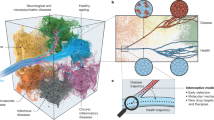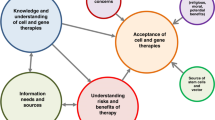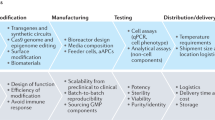Abstract
The publication of new standards for terminology and labeling marks an important step in ensuring consistency and traceability of cellular therapies at the global level. However, it is only with the widespread implementation of the standard that the benefits can be truly realized. This paper provides guidance on the practical aspects of adopting these new standards for organizations with differing current levels of computerization. It discusses project management, equipment, licensing, and validation topics.
This is a preview of subscription content, access via your institution
Access options
Subscribe to this journal
Receive 12 print issues and online access
$259.00 per year
only $21.58 per issue
Buy this article
- Purchase on Springer Link
- Instant access to full article PDF
Prices may be subject to local taxes which are calculated during checkout
Similar content being viewed by others
References
ICCBBA Inc. ISBT 128 Technical Specification, version 3.0.0. January 2007 ICCBBA Inc. www.iccbba.org ISBN 978-1-933243-02-3. ICCBBA, Inc. 1615 Orange Tree Lane, Suite 200 Redlands, CA 92374, USA. Tel: +1 909-266-3140. Fax: 909-266-1828. E-mail: iccbba@iccbba.org; http://www.iccbba.org.
ICCBBA Inc. ISBT 128 Standard: Product Coding—Bounded Lists and Definitions, version 3.3.x. April 2007. http://www.iccbba.org.
ICCBBA Inc. ISBT 128 Standard Product Code Structure and Labeling (Cellular Therapy) Version 2.0.0. January 2007. http://www.iccbba.org.
AABB. Circular of Information for the Use of Cellular Therapy Products. AABB, American Association of Tissue Banks, American Red Cross, American Society for Blood and Marrow Transplantation, American Society for Apheresis, America's Blood Centers, Foundation for the Accreditation of Cellular Therapy, ICCBBA Inc. International Society for Cellular Therapy, National Marrow Donor Program 2005. http://www.aabb.org.
ISO/IEC. Data Matrix Bar Code Symbology Specification, ISO/IEC 16022:2006.
Acknowledgements
The CTCLAG wishes to thank the additional volunteers who participated in writing and reviewing this Implementation Plan.
Author information
Authors and Affiliations
Corresponding author
Appendices
Appendix A
Sample educational summary
Several major organizations from North America and Europe have joined to provide recommendations and guidance for implementing an important safety measure for products—machine-readable or bar-coded labels. With an increasing number of products crossing international lines and variability in product naming and processing procedures, significant margin for error exists. These organizations have worked together to develop uniform nomenclature (Circular of Information) and most recently, uniform-labeling requirements.
With this initiative, the most critical information [facility identifier, unique donation identification number, product name and ABO/Rh (if known)] will be both eye- and machine-readable. Additional mandatory information (such as the expiration and collection dates) that must appear on the label may and may not be bar coded, depending on the size of the label and the amount of information required. Attached labels and accompanying paperwork would carry the remaining information. The group has developed all key elements including label templates, terminology and a simple implementation plan. The plan contains basic information and suggestions for all levels of facility automation, from completely manual to completely automated. There are provisions for those who do not have access to automation, but given the patient safety benefits of computer verification of product and patient identity, it is hoped that all facilities will eventually take this approach.
This system for encoding information and standardized labeling is called ISBT 128. ISBT is the acronym for the International Society of Blood Transfusion, which began the effort to standardize labeling worldwide; 128 is the linear bar code symbology (‘language’) used with ISBT 128. The system has been in use in cellular therapy, blood and tissue banks worldwide for almost a decade.
Appendix B
Bar-coded label validation
Purpose: The purpose of this procedure is to assist in the validation of ISBT 128 bar-coded labels in facilities that apply bar-coded labels but do not normally scan the bar codes.
Scope: This procedure pertains to the scanning of ISBT 128 Donation Identification Number (DIN), ABO and Product Code bar codes.
References: ISBT 128 Standard Technical Specification and User's Manual for bar code scanner.
Equipment: Computer with a text program such as Word or Notepad; Validated bar code scanner capable of reading Code 128; ISBT 128 bar coded labels (Donation Identification Number, ABO/Rh and Product codes).
Procedure
-
1
Open up a text program (such as Microsoft Word or Notepad) to display the scan output.
-
2
Plug the scanner into the same computer as your text program. Activate the necessary symbology on the scanner from the User's Manual.
-
3
Verify whether the scanner can read ISBT 128 data structures by scanning Code 128 bar codes that are usually found in the operator's manual for the scanner.
-
4
Scan bar codes on a sampling of each type of ISBT 128 labels (Donation Identification Numbers, ABO/Rh and Product Codes) to be validated. The scanned information should appear on the screen in your text program.
-
5
Compare the output in the text program against the eye-readable text beneath each bar code. Each output should display a data identifier (see Table below) and followed by the eye-readable text. Characters you should see before the eye-readable text are

-
6
The number of labels that must be scanned to validate the labels is dependent on facility policies and procedures.
-
7
Interpretation:
- 7.1.:
-
Output should match the data identifier plus the eye-readable text beneath the bar code.
- 7.2.:
-
An error message, rather than incorrect data, should appear if problems occur.
- 7.3.:
-
The bar code should be successfully read on the first scan the vast majority of the time.
- 7.4.:
-
Exact acceptance criteria must be established by each facility.
Rights and permissions
About this article
Cite this article
Ashford, P., Distler, P., Gee, A. et al. Terminology and labeling of cellular products–2: Implementation plan. Bone Marrow Transplant 40, 1085–1090 (2007). https://doi.org/10.1038/sj.bmt.1705859
Received:
Accepted:
Published:
Issue Date:
DOI: https://doi.org/10.1038/sj.bmt.1705859
Keywords
This article is cited by
-
ISBT 128: a global information standard
Cell and Tissue Banking (2010)
-
ISBT 128 coding and labeling for cellular therapy products
Cell and Tissue Banking (2010)




